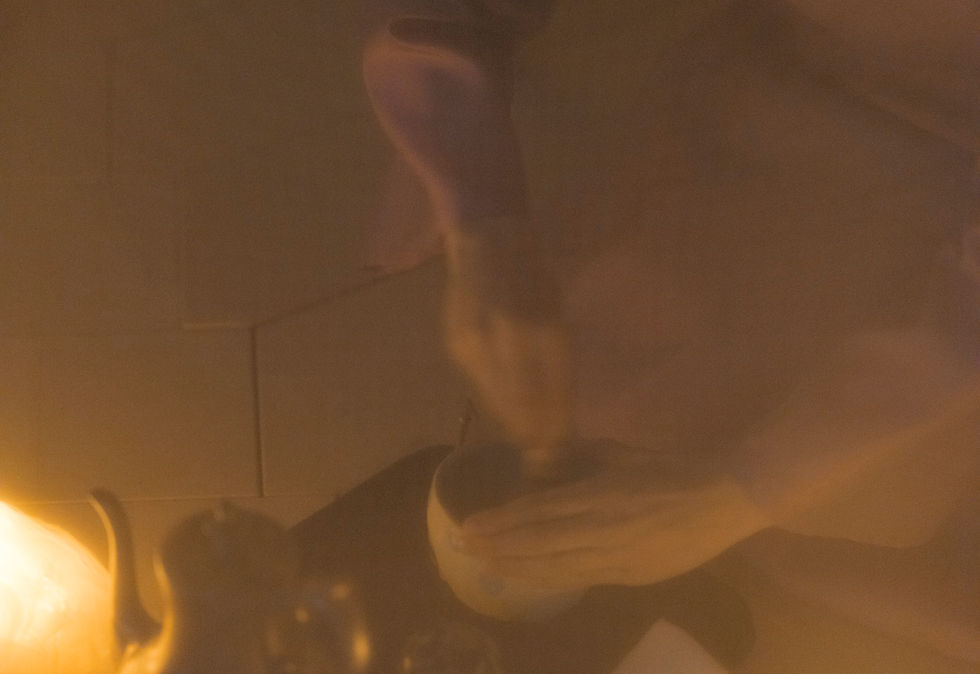『繭の茶室』の茶会 -めぐり-
《繭の茶室》は、福島県・川俣町の伝統的な絹織物「川俣シルク」と、
竹の繊細な躯体によって構成された、移動可能なインスタレーション型茶室です。
2019年から2020年にかけて、京都府京都市・有斐斎弘道館と、
福島県郡山市・麓山荘にて「繭の茶会」として展開され、
茶会の形式を通して「包まれる」体験を共有しました。
本プロジェクトの企画・衣裳デザイン・空間構成を衣裳家の鷲尾華子が担当。
空間構成の中心には、蚕が約1600メートルもの糸を紡ぎ、
自らを回転させながら繭という「内包されたシェルター」をつくる行為への深い感動があります。
その営みを空間構造に重ね、「衣を纏う」ことを拡張し、「空間を纏う」感覚へと昇華させた本作は、身体と精神、自然と技、人と場をつなぐ詩的な装置となりました。
使用素材には、各地の伝統技術と美意識が息づいています。主布には、2009年に誕生した国産繭「ぐんま細」を群馬県の碓氷製糸で糸にし、福島県川俣町の紺野機業場にて織布。
衣裳には、宮崎県・綾の手紬染織工房にて染められた「大和貝紫染」と「藍染」の天然染料による染色技術を用いています。
光を透過する絹の膜が、空間に静かな時間と呼吸をもたらします。 構造体は5mmの竹籤で構成され、FOAS 大橋史人建築設計との協働により制作。建築・衣裳・身体・伝統工芸が交差するこの取り組みは、令和元年度「地域経済産業活性化対策費補助金(地域の伝統・魅力等発信支援事業)」の採択を受けて実施されました。
|concept|
蚕は、メビウスの輪のような動きを繰り返しながら⽷を張り巡らせ、繭を形成していきます。
途切れることのない⽷は、⻑さ約1,500mとも⾔われ⾃らを守る尊い空間です。
希少な国産絹⽷を⽤いた織物で構成する「繭の茶室」は、
繭の構造から構想を得て、⽵の躯体に極薄の⼆重織「川俣シルク」を張り巡らせて
制作した茶室空間です。
また、茶⼈が着⽤する⾐装には、古法の藍染めと⾙紫で染めた⽷で織り製作しました。
透明感のある柔らかな円形の空間に包まれ、⼀服のお茶をいただきながら
過去・現代・未来へと脈々と続く絹⽂化と⼈々の営み、
そして⾃然界に思いをめぐらせる場となりますように。
企画・茶室構成・衣裳デザイン・制作統括
|鷲尾華子
躯体設計|大橋史人
織|有限会社紺野機業場
染|綾の手紬織工房
糸|碓氷製糸
和紙|ハタノワタル
撮影|宮下直樹
施工|沼田雄一
茶人|三窪笑り子 Kristyna Cislerova 太田宗達
協力者|濱崎加奈子
場所|有斐斎 弘道館
日時|2019年1月19日 KYOTO, JAPAN|2019.12
“Mayu no Chashitsu” (Cocoon Tea Room) is a mobile installation-style tea room constructed from traditional silk textiles of Kawamata Town, Fukushima Prefecture—specifically “Kawamata Silk”—and a delicate bamboo framework. From 2019 to 2020, it was exhibited as the “Mayu no Chakai” (Cocoon Tea Gathering) at both Yuhisai Kodokan in Kyoto City, Kyoto Prefecture, and Rokuzanso in Koriyama City, Fukushima Prefecture, sharing the immersive experience of “being enveloped” through the form of a tea gathering.
The project’s planning, costume design, and spatial composition were led by costume designer Hanako Washio. At the heart of the spatial design lies a profound inspiration drawn from the silkworm’s act of spinning approximately 1,600 meters of thread and rotating itself to create the “enclosed shelter” known as the cocoon. This natural process is metaphorically layered onto the spatial structure, expanding the concept of “wearing clothes” into a transcendent sensation of “wearing space.” The work thus becomes a poetic device connecting body and mind, nature and technique, and people and place.
The materials used embody the traditional techniques and aesthetics of various regions. The main fabric features domestically produced silk threads from “Gunma Hoso,” cocoons born in 2009, spun by Usui Silk Mill in Gunma Prefecture, and woven by Konno Textile Workshop in Kawamata Town, Fukushima Prefecture.
The costumes employ natural dyeing techniques using “Yamato Kai-murasaki” (purple shell dye) and indigo dyes, created at the hand-spun weaving studio in Aya, Miyazaki Prefecture. The silk’s translucent membrane brings a quiet time and breathing presence to the space.
The structural frame is made from 5mm diameter bamboo splints, produced in collaboration with architect Fumito Ohashi of FOAS. This interdisciplinary endeavor—intersecting architecture, costume, body, and traditional crafts—was supported by the “Regional Economy and Industry Revitalization Subsidy (Support Project for Promoting Local Traditions and Attractions)” awarded in the first year of Reiwa.




























